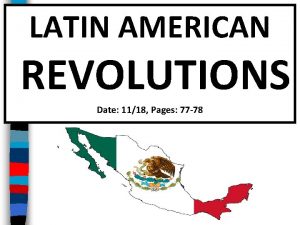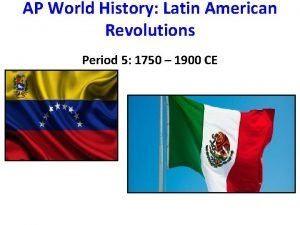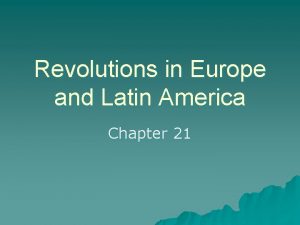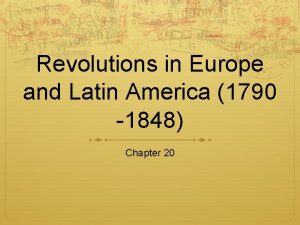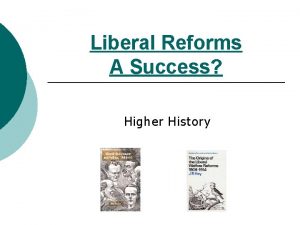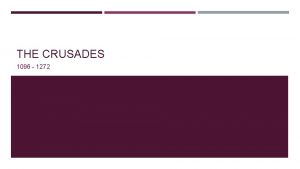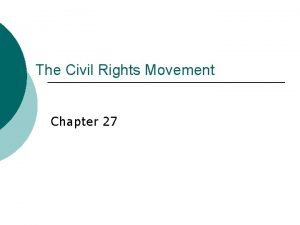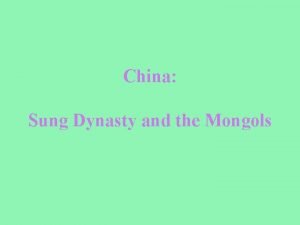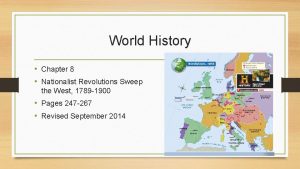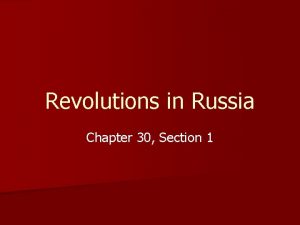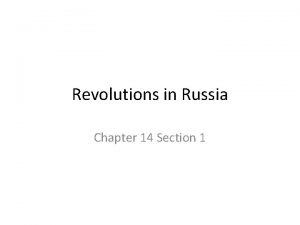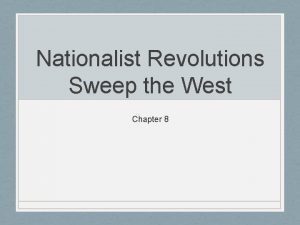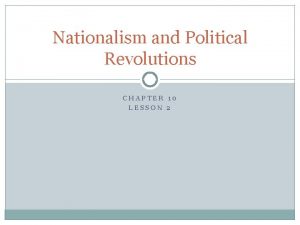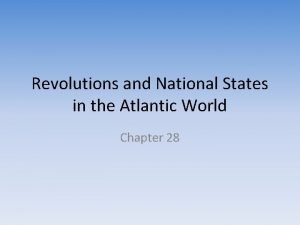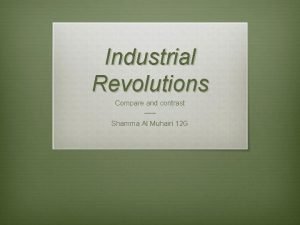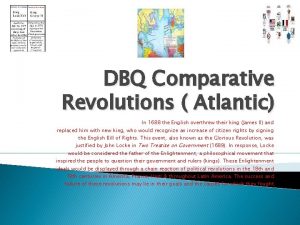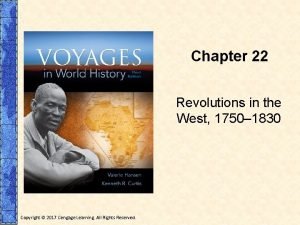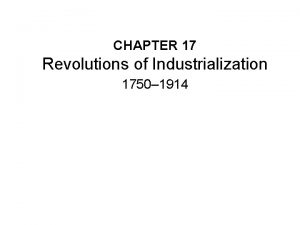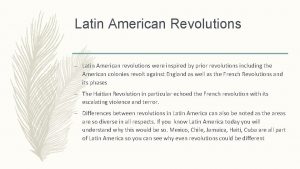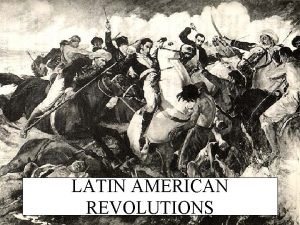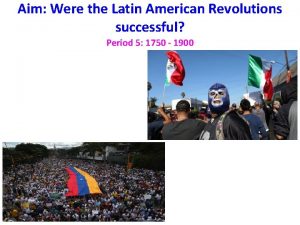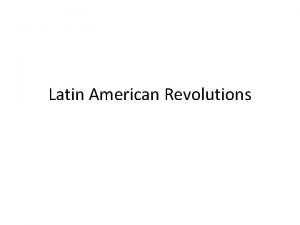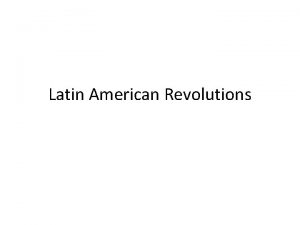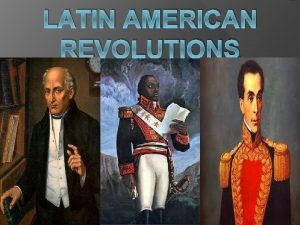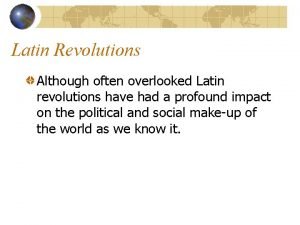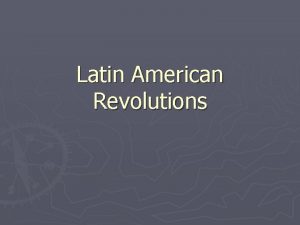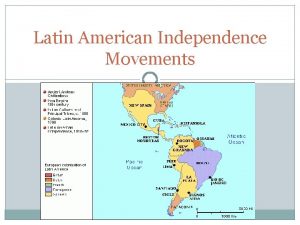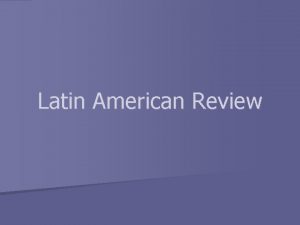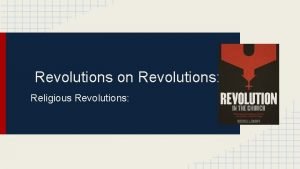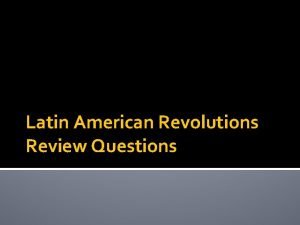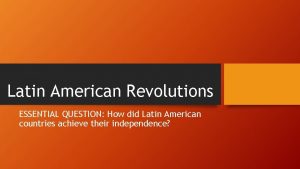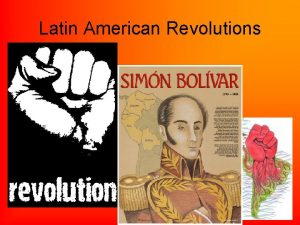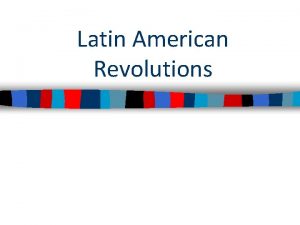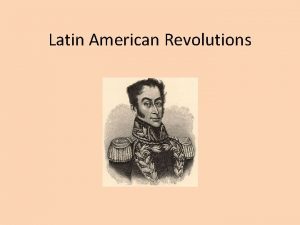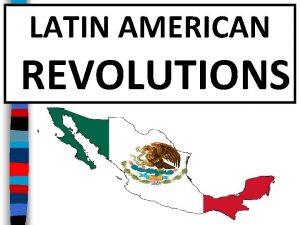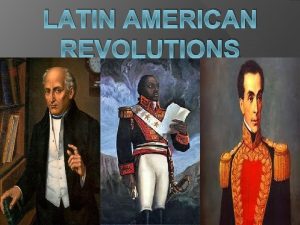Aim How Successful Were the Latin American Revolutions




















- Slides: 20

Aim: How Successful Were the Latin American Revolutions? Units 5 and 6: 1750 - 1900 What is Latin America? Culturally and linguistically, Latin America consists of nations in the Americas and the Caribbean whose residents predominantly speak Spanish or Portuguese (both derived from Latin).

I Causes A) Mercantilism and the encomienda system unequal social divisions B) The enlightenment inspired liberalism. Liberalism is the idea of liberty, equality, and popular sovereignty. Liberals wanted to end the dominance of the Catholic Church, class stratification and slavery, and advocated for democracy. This clashed with the conservatives who favored existing social and political systems. C) Creoles were socially inferior to peninsulares despite having wealth & education. D) Inspiration of earlier American, French, & Haitian Revolutions.


II The Mexican Revolution A) 1810, a poor but well-educated Catholic Creole priest Miguel Hidalgo of the small town on Dolores, uttered the “Cry of Dolores” against Spain for independence. He led an army of 80, 000 Natives & mestizos. Hidalgo was killed but new leaders continued the fight. B) 1820 the Creoles, fearing they would lose their wealth, switched sides & joined the revolt against Spain. C) 1821 Spain granted Mexico its independence. D) After a short-lived Mexican Empire, the Catholic monarchy was overthrown, and a federal republic declared 1823, and officially recognized by Spain in 1836. Miguel Hidalgo 1753 - 1811 "Action must be taken at once; there is no time to be lost; we shall yet see the oppressors' yoke broken and the fragments scattered on the ground. "

Miguel Cabrera - Altarpiece of the Virgin of Guadalupe with Saint John the Baptist, Fray Juan de Zumárraga and Juan Diego Hidalgo marched with a banner decorated with the Virgin of Guadalupe (1531 the Virgin Mary purportedly appeared to an indigenous Mexican). The Virgin of Guadalupe became a symbol of Mexican resistance and independence.

Why Does Mexico Celebrate Cinco de Mayo? In 1861 Mexican Benito Juarez became president of Mexico when it was greatly in debt. He was forced to default to European governments. France, Britain, and Spain sent naval forces to Veracruz to demand reimbursement. Britain and Spain negotiated with Mexico and withdrew, but France, ruled by Napoleon III, used the opportunity to imperialize. Late in 1861, a French fleet stormed Veracruz, and drove President Juarez into retreat. From the north in Puebla, Juarez rounded up an army led by Texas-born General Ignacio Zaragoza. May 5, 1862, during the Battle of Puebla the French finally retreated. They had lost nearly 500 soldiers to the fewer than 100 Mexicans killed. While not a major victory, Zaragoza’s victory at Puebla symbolized the country’s ability to defend its sovereignty against threat by a powerful foreign nation. Today, Mexicans celebrate the anniversary of the Battle of Puebla as Cinco de Mayo. Six years later, under pressure from the newly reunited United States, France withdrew. Abandoned in Mexico, Emperor Maximilian, installed as emperor of Mexico by French Emperor Napoleon III in 1864, was captured by Juarez’ forces and on June 19, 1867, was executed. Benito Juarez Napoleon III General Ignacio Zaragoza

Cinco de Mayo Execution of Emperor Maximillian of Mexico by Manet Emperor Maximillian of Mexico 1832 – 1867 (From Austria!)

III Bolivar and San Martin A) 1811 - 1824, Venezuelan Creole Simon Bolivar led an army of revolutionaries against Spain. Bolivar wanted to create a single unified nation of Grand Colombia under a federal constitution modeled after the US. The plan failed because of the differences of the Latin American peoples. Political disputes the new independent colonies became divided into Bolivia, Colombia, Panamá, & Ecuador. B) Argentinean creole Jose San Martín led the independence movement in southern South America new nations of Argentina, Chile & Peru.

Simon Bolivar Jose de San Martin Success will crown our efforts, because the destiny of America has been irrevocably decided; the tie that bound her to Spain has been severed. Only a concept maintained that tie and kept the parts of that immense monarchy together. That which formerly bound them now divides them. The hatred that the [Iberian] Peninsula has inspired in us is greater than the ocean between us. Simon Bolivar, Letter from Jamaica 1815 “May slavery be banished forever together with the distinction between castes, all remaining equal, so Americans may only be distinguished by vice or virtue. . . In the new laws, may torture not be allowed. ” Jose de San Martin


San Martin’s Masoleum, Buenos Aries Cathedral

IV Brazil A) 1808 the Portuguese Royals fled to Brazil during the Napoleonic Wars. *They were the only Royal family to rule their colony FROM their colony! B) 1815 João VI raised Brazil to the status of a kingdom with Rio de Janeiro as its capital. C) João VI was coerced to return to Portugal in 1821 to help write a constitution. He left his son Pedro I “The Liberator” as Prince Regent of Brazil. D) Brazilians were upset that Portugal wanted to return Brazil to the status of a colony. Pedro I, on the advice of Brazilian nationalists and help of the British, declared Brazil's independence from Portugal September 7, 1822. December 1, Pedro I was crowned Emperor. E) By the 1820 s had become Great Britain's third-largest export recipient. Slavery remained, as did sugar and coffee plantations. João VI (1767 – 1826) Pedro I 1798 - 1834

Slaves at a Coffee Farm Sao Paulo, Brazil 1882




V Monroe Doctrine “President James Monroe’s 1823 annual message to Congress contained the Monroe Doctrine, which warned European powers not to interfere in the affairs of the Western Hemisphere… The Monroe Doctrine was invoked in 1865 when the U. S. government exerted diplomatic and military pressure in support of the Mexican President Benito Juárez. This support enabled Juárez to lead a successful revolt against the Emperor Maximilian, who had been placed on the throne by the French government. Almost 40 years later, in 1904, European creditors of many Latin American countries threatened armed intervention to collect debts. President Theodore Roosevelt proclaimed the right of the US to exercise an “international police power” to stop it. As a result, U. S. Marines were sent into Santo Domingo in 1904, Nicaragua in 1911, and Haiti in 1915 to keep the Europeans out…” –ourdocuments. gov The Monroe Doctrine was also backed by Britain.

The Monroe Doctrine “The American continents…are henceforth not to be considered as subjects for future colonization by any European powers. ” - James Monroe, 1823


Key Vocabulary Benito Juarez Bernardo O'Higgins Ferdinand Maximilian Francisco de Miranda General Manuel Belgrano General Zaragoza João VI Jose De San Martin Jose Miguel Carrera Liberals vs. Conservatives Monroe Doctrine Napoleon III Pedro I “The Liberator” Simon Bolivar
 Latin american revolutions date
Latin american revolutions date Jose de san martin definition world history
Jose de san martin definition world history Revolutions in europe and latin america section 2 quiz
Revolutions in europe and latin america section 2 quiz Revolutions in europe and latin america
Revolutions in europe and latin america Liberal reforms essay
Liberal reforms essay Were the crusades successful
Were the crusades successful Why were sit-ins often a successful tactic
Why were sit-ins often a successful tactic Sung empire
Sung empire Chapter 8 nationalist revolutions sweep the west
Chapter 8 nationalist revolutions sweep the west Chapter 30 revolutions in russia
Chapter 30 revolutions in russia Chapter 14 section 1 revolutions in russia
Chapter 14 section 1 revolutions in russia Europe faces revolutions
Europe faces revolutions French revolution political spectrum
French revolution political spectrum Atlantic revolutions in a global context
Atlantic revolutions in a global context Commercialization ap human geography
Commercialization ap human geography Revolutions and national states in the atlantic world
Revolutions and national states in the atlantic world Shamma al muhairi
Shamma al muhairi Atlantic revolutions dbq
Atlantic revolutions dbq 22 revolutions
22 revolutions Chapter 17 revolutions of industrialization
Chapter 17 revolutions of industrialization Building revolutions
Building revolutions
